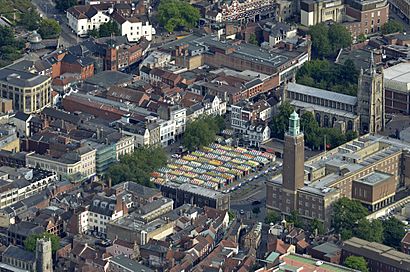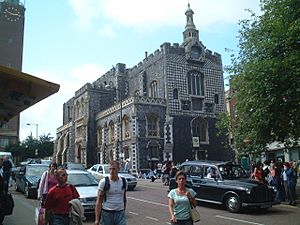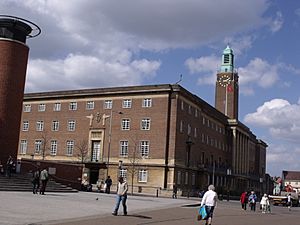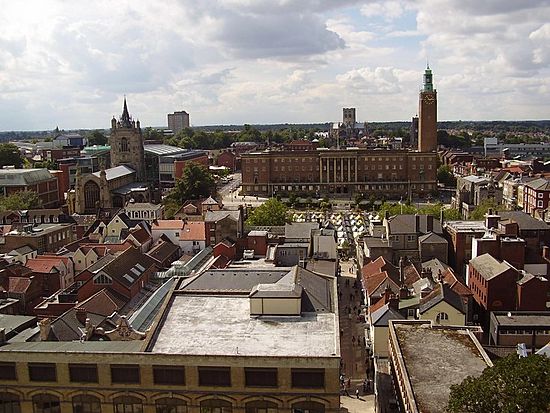Norwich Market facts for kids
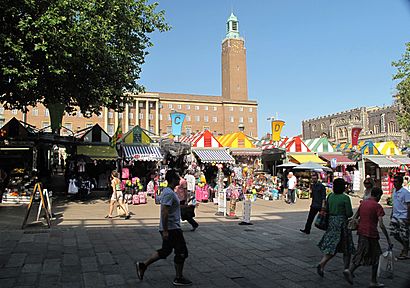
Norwich Market (also known as Norwich Provision Market) is a large outdoor market in the centre of Norwich, England. It has around 200 stalls and is one of the oldest and largest outdoor markets in Britain. It was started by the Normans in the 11th century and has been in the same spot for over 900 years.
The market has been changed and rebuilt many times. In the 1930s, it was redesigned with rows of stalls covered by colourful striped roofs, which became its most famous feature. In 2006, it was rebuilt again with modern stalls to make it better for both shoppers and sellers. Today, it is a popular place for locals and a major attraction for tourists.
Contents
History of the Market
How It All Began
The city of Norwich is the county town of Norfolk in the East of England. Before the 11th century, the main market was in an area called Tombland.
In 1066, England was conquered by the Normans, who came from a part of France called Normandy. They rebuilt much of Norwich, adding a castle and a cathedral. They also created a new town centre to the west of the castle, in an area called "Mancroft."
A new market was set up in Mancroft to serve the Norman settlers. The old market at Tombland was eventually closed. The new market was owned by the King, who collected taxes from the traders.
The Market in the Middle Ages
By the 1300s, Norwich was one of the biggest and wealthiest cities in England. The market was a very busy place where farmers and craftspeople from all over the region came to sell their goods. You could buy grain, sheep, cattle, cloth, and leather.
The market was a large rectangle with the church of St Peter Mancroft at the southern end and a tollhouse (where taxes were collected) at the northern end. The stalls were arranged in rows, and each section of the market sold different things. There were rows for fishmongers, butchers, and people selling wool.
In 1341, King Edward III gave control of the market to the city of Norwich. This was a big event because it meant the city could make its own rules and keep the money from the stalls. The city leaders made rules to make sure trading was fair. For example, they set the prices for bread and beer and checked that everyone used proper weights and measures.
A Time of Great Sadness
In the middle of the 14th century, a terrible sickness known as the Great Mortality (or the Black Death) spread across Europe. It reached Norwich in 1349 and was a very sad time for the city. More than half of the people in the region died.
The market became much quieter for many years, and many stalls were left empty. But Norwich slowly recovered. The merchants who survived helped to rebuild the city's economy.
The Guildhall and Market Cross
In the early 1400s, the old tollhouse was replaced with a grand new building called the Guildhall. It became the centre for the city's government and law courts. It is the largest medieval civic building in Britain outside of London.
Around the same time, a special cross called a market cross was built in the centre of the market. It was a tall, decorated stone structure. In the 1700s, the cross was taken down because it was expensive to repair.
The market square was also a public space. Important announcements were made there. It was also where people who broke the law were publicly punished, using things like stocks, to show others what would happen if they didn't follow the rules.
A Fashionable Shopping Place

In the 1700s, Norwich became a popular city for wealthy people to visit. The area around the market became a fashionable shopping district. The eastern side of the market, known as Gentleman's Walk, had many luxury shops and large inns for travellers.
The market itself became very crowded. By the 19th century, the narrow streets around it were often jammed with people, carts, and animals. The city wanted to make improvements, but it was hard to raise the money. Some new streets were built to help with the traffic, and gas lighting was installed in 1820.
The Modern Market
The Big 1930s Makeover
After the First World War, the city council bought all the market stalls so that the entire market was owned by the public.
By the 1930s, the old Guildhall was too small to be the city's main government building. The council decided on a radical plan to completely redevelop the area. The buildings that divided the market were knocked down, creating one large, open space.
All the old stalls were removed and replaced with 205 new stalls, neatly arranged in parallel rows. In 1938, the stalls were given colourful striped roofs, or "tilts," which became a famous symbol of Norwich.
A huge new City Hall was built along the entire western side of the marketplace. It was opened in 1938 by King George VI and is still the home of the city council today.
Rebuilding in the 21st Century
By the 1990s, the 1930s market was showing its age. The stalls were getting worn out, and the narrow walkways were dark and crowded. The floors of the stalls were on a slope, which was uncomfortable for people working in them all day.
In 2005, a major rebuilding project began. To allow traders to keep working, temporary stalls were set up on nearby streets while the new market was built.
The new design kept the famous parallel rows and colourful roofs. But the old stalls were replaced with modern steel and aluminium units, often called "pods." Each pod contains four stalls and has a level floor, making it much better for the traders. Transparent canopies were also added over the walkways to provide shelter from the rain. The rebuilt market officially opened in 2006.
Today, Norwich Market is still a bustling centre of city life. While there are fewer fruit and vegetable stalls than in the past due to competition from supermarkets, many stalls now sell specialty foods, unique gifts, and clothing. It remains one of Britain's greatest markets, loved by both locals and visitors.
See also
 In Spanish: Mercado de Norwich para niños
In Spanish: Mercado de Norwich para niños


